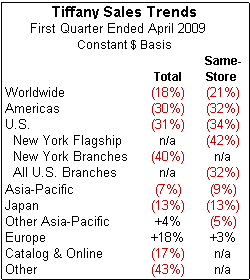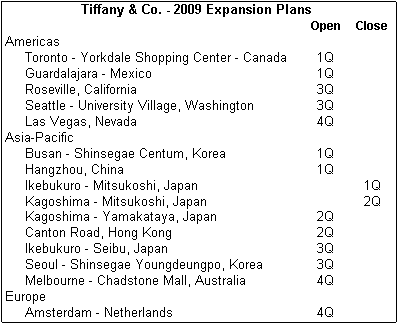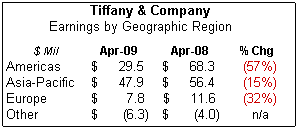IDEX Online Research: Tiffany & Co. - “There’s Light at the End of the Tunnel”
June 07, 09
Despite disappointing financial results for its first fiscal quarter ended April 2009, Tiffany & Co. chairman Mike Kowalski declared, “We are now almost one month [May] into our second [fiscal] quarter, and, although it’s still too early to draw any conclusions, we are seeing a lessening in the rate of year-over-year total sales decline.”
Tiffany & Co. has been one of the hardest hit jewelers during the current recessionary environment, primarily because it is a higher end jeweler, a segment which has been particularly affected – negatively – by reduced consumer spending.
While worldwide sales were down 22 percent (down 18 percent on a constant currency basis) in the first quarter, Tiffany management is forecasting that total worldwide sales will be down about 11 percent for the full year. Clearly, they – along with many others including IDEX Online Research – believe that the worst is over, and that sales comparisons likely will be less disappointing in subsequent quarters in 2009.
The table below summarizes key financial data for Tiffany & Company’s first fiscal three-month period ended April 2009. It is important to note that, although the financials are disappointing, Tiffany & Co. earned a solid profit in the quarter, with a pretax margin of 8.0 percent. Most specialty jewelers post a loss in the first quarter.

Source: Company reports
First Quarter Highlights
The following are highlights from Tiffany & Company’s first quarter financial results.
- Sales by geographic region are summarizes on the table below:

Source: Company reports
Clearly, the weakest global region is the U.S. In New York, the company’s flagship store, which typically represents about 10 percent of corporate revenues, posted a highly disappointing 42 percent drop in sales. Management attributed this sharp decline to turmoil in the financial markets; Wall Street employees represent a notable segment of Tiffany’s New York customer base. In addition, the number of foreign tourists shopping in the New York Flagship store has declined, especially as the U.S. dollar rose in value earlier this year.
- Weak sales in the U.S. market were due to two factors: 1) fewer transactions (just over half of the decline); and, 2) a drop in the average ticket (just under half of the sales decline).
- Tiffany’s price stratification analysis showed that demand across virtually all price points declined, though management noted that sales of goods priced above $50,000 were the weakest category.
- U.S. sales were down 34 percent in February, dropped by 39 percent in March, and declined by 30 percent in April. Management’s comments would imply that sales in May were down by a smaller percentage than April’s decline of 30 percent; our estimate is that they declined in the high 20 percent range (perhaps down by 28-29 percent).
- Tiffany noted that the competitive landscape has been particularly brutal, with some jewelers discounting extremely heavily, and others engaging in liquidation / going-out-of-business sales. Management commented, “It is difficult to say when these competitive headwinds will dissipate, but they surely will.” Like most industry players, Tiffany management implied that the number of store closings will likely be large this year.
- By merchandise category, the best performing categories were fashion silver and gold jewelry both smaller ticket items. Bridal jewelry remains a very strong category, though sales declined year-over-year. Watch sales were also lower in the first quarter.
- Tiffany’s e-commerce and catalog business suffered a sales decline of 17 percent due to significantly fewer orders and a slightly lower average ticket.
- Tiffany’s sales in its “Other” segment – mostly wholesale diamonds and Iridesse – were down 17 percent. The Iridesse stores, slated for closing this year, posted higher sales, while wholesale diamond sales fell due to weaker sales, especially among diamond traders.
- Tiffany’s stores in Canada, Latin America and South America posted only modest same-store sales weakness. During the first fiscal quarter, the company opened a new store in Toronto – its second – and a store in the Palacio De Hierro department store in Guardalajara, Mexico.
Tiffany’s stores in Europe all posted sales gains in a very narrow range, reflecting the same-store sales increase of 3 percent in the quarter.
The table below summarizes planned store openings and closings in 2009.
 Source: Company reports |
- Tiffany’s 209 company-owned stores generated a profit for the company, though profits were not consistent across each geographic region, as the table below illustrates. Sales in the Americas were particularly weak, and profits reflected this weakness.
 Source: Company reports |
- Despite weak sales and disappointing profits, Tiffany & Company management did not change its outlook for the balance of 2009 which calls for a worldwide sales decline of 11 percent, with a mid-teen decline in the Americas, a mid-single-digit decline in the Asia-Pacific region (in dollars), and a high single-digit decline (in dollars) in Europe, though same-store sales are expected to be about flat on the continent. In the “Other” category – wholesale diamonds and Iridesse – sales are forecasted to be down about 20 percent for the year. On an operating basis, Tiffany is expected to post a solid profit in 2009.